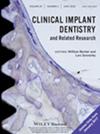Assessment of the application of a novel three-dimension printing individualized titanium mesh in alveolar bone augmentation: A retrospective study
Abstract
Objective
To assess the clinical and radiographic outcomes of alveolar ridge augmentation using a novel three-dimensional printed individualized titanium mesh (3D-PITM) for guided bone regeneration (GBR).
Materials and methods
Preoperative cone-beam computed tomography (CBCT) was used to evaluate alveolar ridge defects, followed by augmentation with high-porosity 3D-PITM featuring circular and spindle-shaped pores. Postoperative CBCT scans were taken immediately and after 6 months of healing. These scans were compared with preoperative scans to calculate changes in bone volume, height, and width, along with the corresponding resorption rates. A statistical analysis of the results was then conducted.
Results
A total of 21 patients participated in the study, involving alveolar ridge augmentation at 38 implant sites. After 6 months of healing, the average bone augmentation volume of 21 patients remained at 489.71 ± 252.53 mm3, with a resorption rate of 16.05% ± 8.07%. For 38 implant sites, the average vertical bone increment was 3.63 ± 2.29 mm, with a resorption rate of 17.55% ± 15.10%. The horizontal bone increment at the designed implant platform was 4.43 ± 1.85 mm, with a resorption rate of 25.26% ± 15.73%. The horizontal bone increment 2 mm below the platform was 5.50 ± 2.48 mm, with a resorption rate of 16.03% ± 9.57%. The main complication was exposure to 3D-PITM, which occurred at a rate of 15.79%.
Conclusion
The novel 3D-PITM used in GBR resulted in predictable bone augmentation. Moderate over-augmentation in the design, proper soft tissue management, and rigorous follow-ups are beneficial for reducing the graft resorption and the incidence of exposure.

 求助内容:
求助内容: 应助结果提醒方式:
应助结果提醒方式:


